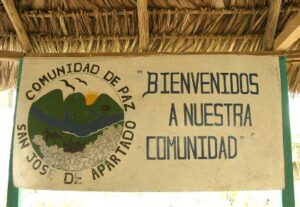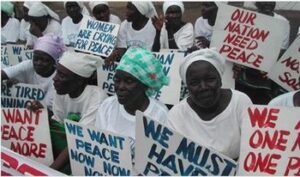Minds of the Movement
An ICNC blog on the people and power of civil resistance
by Luke Abbs and Marina G. PetrovaJuly 30, 2021
In February 2006, as Nepal entered its tenth year of civil war, with several failed ceasefires, there was little prospect for peace with the Maoist rebels.
Yet two months later, after forming an alliance with Nepal’s Seven Party Opposition, the Maoists joined a national strike. This initiated a pro-democracy nonviolent movement that successfully removed King Gyanendra from power and led to a peace agreement, achieving in a few months what the armed rebellion had failed to achieve in ten years.
The case of Nepal reminds us that ordinary people are not powerless actors in the context of civil war. The civil society organizations (CSOs) they form can influence the trajectory of violent conflict and its peaceful resolution.
Academic research on the impact of nonviolent action on peace has been limited, but emerging research has already revealed three key factors:
The presence of one or more nonviolent campaigns during armed domestic conflict increases the chances of a peace agreement
A forthcoming monograph, ICNC-funded monograph finds evidence that nonviolent campaigns contribute to peace across a global set of cases. Where civil resistance campaigns have been present, a peace settlement to civil war was three times more likely to occur than in cases where nonviolent campaigns were absent.
Why? Nonviolent movements open up opportunities for peace by forcing government concessions or by removing dictatorships. Further, they engage in constructive activities, including promoting civil society and inclusion in order to redefine societal relations. The monograph also finds that the legacy of these campaigns increases the likelihood of democratization after armed conflict comes to an end.
CSOs active during civil wars deploy a diverse range of nonviolent tactics
A variety of nonviolent tactics are used within and outside the context of civil war. In 1973, Gene Sharp outlined 198 methods of nonviolent action, with Michael Beer recently adding 148 new tactics to a growing list. These can be broadly categorized as:
- Persuasive acts (i.e. protests and demonstrations)
- Non-cooperation (i.e. strikes and boycotts)
- Nonviolent intervention (i.e. sit-ins, occupations and the creation of alternative institutions)
Other scholars point to additional political engagement tactics during peace processes, such as dialogue, consultation, advocacy, education, monitoring and bridging activities.
For instance, the South Sudan Civil Society Forum (SSCSF) has relied on persuasive (i.e. demonstrations) and engagement tactics (peace advocacy, challenging human rights abuses) to support the peace process, following seven years of civil war.

A welcome sign at the entrance to the Peace Community of San José De Apartadó, Colombia. Source: Comunidad de Paz San José De Apartadó Facebook page.
Peace movements—a diverse set of actors—have been shown to positively impact peace processes using a range of actions that resemble those used by civil resistance campaigns. For instance, the Women of Liberia Mass Action for Peace (WLMAP) were anti-violence and used protests and sit-ins to pressure the warring parties into ending the civil war.
In conflict zones, CSOs more commonly deploy nonviolent action against non-state armed groups to prevent violence. The Peace Community of San José de Apartadó (PCSJA) in Colombia used a variety of nonviolent tactics to create “zones of peace,” where civilians “nudge” armed groups to abide by protection norms, mitigating their impact on civilians.
In other contexts, civilians have organized unarmed civilian-led peacekeeping (UCP), contributing to peace infrastructure by monitoring human rights and ceasefire violations. One such example is the Bantay Ceasefire initiative, which monitored the ceasefire in Mindanao, the Philippines.
Specific tactics and sequencing of nonviolent action matter

The Women of Liberia Mass Action for Peace, founded in 2003, worked to end the Second Liberian Civil War. Source: Wikipedia via Women In World History (low resolution, fair use image ©Pray the Devil Back to Hell).
Regardless of context, targets and goals, nonviolent action is successful when used strategically and sequenced at the right moments.
Novel research supported by the United States Institute of Peace explores the impact of nonviolent tactics on different aspects of a peace process: the intensity of armed violence, initial negotiations between warring parties, and subsequent peace settlements.
Overall, this study finds divergent effects. Protest and political engagement tactics are associated with an increased likelihood of initial negotiations but have little effect on later peace settlements. Maintaining nonviolent mobilization is challenging, and CSOs, which are frequented excluded from peace settlements, often lose influence in later stages of a peace process.
Engagement in disruptive nonviolent intervention tactics, such as sit-ins and occupations, can ensure that civil society continues to have an impact on a peace process, increasing the likelihood of a signed peace agreement. This is best illustrated by the case of Liberia’s Women in Peacebuilding Network (WIPNET) and its use of sit-ins to support the Comprehensive Peace Agreement.
Finally, non-cooperation tactics, such as strikes and boycotts, appear to reduce conflict intensity, complementing findings from Colombia on how local actors use non-cooperation as a strategy for violence prevention.
The emerging literature highlights the positive impact of nonviolent action during civil war. International actors, NGOs and the media would do well to recognize the role and importance of CSOs that use nonviolent action, and support their disruptive and constructive actions to further aid peacebuilding efforts.

Luke Abbs
Dr. Luke Abbs is a research fellow at the Centre for Religion, Reconciliation and Peace (CRRP) and visiting fellow at the Department of Government, University of Essex, UK. Along with a forthcoming ICNC monograph tentatively titled, “The Impact of Nonviolent Resistance on Civil War Resolution”, his work has been published in the Journal of Peace Research, Journal of Conflict Resolution, the Journal of Global Security Studies and Mobilization.
Read More
Marina G. Petrova
Marina G. Petrova is a Post-Doctoral Research Fellow at the Department of Social and Political Sciences, Università Bocconi in Milan, Italy. She received her PhD from the Department of Government, University of Essex in Colchester, UK. Her research interests include political violence, nonviolent action, and conflict processes.
Read More